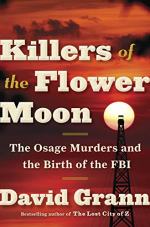
|
| Name: _________________________ | Period: ___________________ |
This test consists of 5 multiple choice questions, 5 short answer questions, and 10 short essay questions.
Multiple Choice Questions
1. When Tom White married in 1908, whom did he marry?
(a) Martha Mattingly.
(b) Anna Brown.
(c) Rita Smith.
(d) Bessie Patterson.
2. About what crime did Ernest forever claim to have had no prior knowledge?
(a) The attempts to poison Mollie.
(b) The pushing of W.W. Vaughn from the train.
(c) Charles Whitehorn's murder.
(d) The shooting of Anna.
3. Before joining the Justice Department, J. Edgar Hoover had been a clerk at what location?
(a) The Department of Transportation.
(b) The Treasury Department.
(c) The Smithsonian.
(d) The Library of Congress.
4. Soon after the grand jury proceedings against William Hale began, one of his "cronies" (200), who also happened to be a pastor, was charged with committing what crime?
(a) Theft.
(b) Perjury.
(c) Witness tampering.
(d) Assault.
5. How much did Ernest Burkhart offer to pay Burt Lawson for murdering Bill Smith?
(a) $50,000.
(b) $25,000.
(c) $5,000.
(d) $15,000.
Short Answer Questions
1. William Hale once said, "I, like many other good men, believed it would be only a short time until Congress would pass a law" (160) that permitted what practice?
2. What changed William Hale's initial reaction to the news that his case would have to be tried in state court?
3. Who was the last person who had to die before Ernest Burkhart would control all of his wife's family's headrights?
4. What is NOT one thing Mollie said in defense of her husband Ernest at the time of his arrest?
5. In 1926, Ernest Burkhart was sentenced to what punishment for his crimes?
Short Essay Questions
1. What is the significance of the photograph in the text that depicts a roping contest from 1909?
2. What did Tom White's investigation into the system of Osage guardianship reveal?
3. What does the author consider to be the most damning evidence that Mollie's illness was being caused by poison?
4. What does the author mean when he describes the Shoun brothers as "seemingly ubiquitous" (158) when he discusses their involvement in Henry Roan's insurance policy dealings?
5. What evidence does the author provide to support his claim that Tom White "was feeling pressure not just from Hoover" (171)?
6. What did the men on the list of witnesses for the prosecution of William Hale have in common?
7. How was John Ramsey's confession laden with the era's racist views held by whites about Native Americans?
8. What did the Osage man mean when he told a reporter, "Tell everybody, when you write your story, that they're scalping our souls out here" (156)?
9. How is paradox apparent within the question of which government entity had jurisdiction over the Osage murders?
10. The author surmises that if widely circulated rumors are true, then Hale had killed his own unborn baby. What were these conditions?
|
This section contains 1,540 words (approx. 6 pages at 300 words per page) |

|




